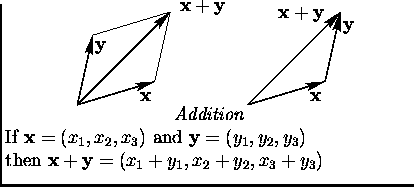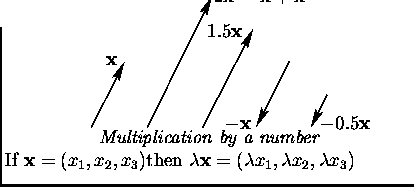

Vectors, operations on vectors, coordinates.


Obvious properties of the operations.
![$\begin{array}[t]{rcl}
(\mbox{\bf x}+\mbox{\bf y})+\mbox{\bf z}&=&\mbox{\bf x}+(...
... x}+\mbox{\bf0}&=&\mbox{\bf x}\\
0\cdot \mbox{\bf x}&=&\mbox{\bf0}
\end{array}$](img10.gif)
Proposition. If
![]() ,
...,
,
...,
![]() are
linearly dependent then vectors
are
linearly dependent then vectors
![]() ,
...,
,
...,
![]() ,
,
![]() ,
...,
,
...,
![]() is
also linearly dependent for arbitrary vectors
is
also linearly dependent for arbitrary vectors
![]() ,
...,
,
...,
![]() .
.
Theorem. Suppose r>n. Then any r vectors
![]() ,
...,
,
...,
![]() in
in ![]() are linearly dependent.
are linearly dependent.
Example. Vectors
![]() and
and
![]() are linearly dependent if and only if
are linearly dependent if and only if
 .
.
Theorem. Any set of n linearly independent
vectors in ![]() is a basis of
is a basis of ![]() .
.
Theorem. Suppose
![]() ,
...,
,
...,
![]() are
linearly independent vectors in
are
linearly independent vectors in ![]() and r<n. Then there exist
vectors
and r<n. Then there exist
vectors
![]() ,
...,
,
...,
![]() such that the set
{
such that the set
{
![]() ,
...,
,
...,
![]() ,
,
![]() ,
...,
,
...,
![]() }
is a basis of
}
is a basis of ![]() .
.